Industrial Fans
Below are six of the more popular design of industrial fans:
Axial-flow Fans
There are four types of axial-flow fans. Listed in the order of increasing static pressure,they are;
Propeller Fans
The propeller fan, sometimes called the panel fan, is the most commonly used of all fans. It can be found in industrial, commercial, institutional and residential applications. It can exhaust hot or contaminated air or corrosive gases from factories, welding shops, foundries, furnace rooms, laboratories, laundries, stores or residential attics or windows.
Sometimes several propeller fans are installed in the walls of a building, operating in parallel and exhausting the air, towards the ceiling where the hot air is located.
Belt driven, electric motor fans consist of the following 11 components: a spun venturi housing, a bearing base (plus braces), two bearings, a shaft, a motor base, an electric motor, two pulleys, a belt and a fan wheel. Having the motor located opposite the rotating fan blades results in good motor cooling but some obstruction to the airflow.
A simpler configuration of a propeller fan with direct drive from an electric motor is possible. This unit consists of just 4 components: a spun venturi housing, a motor base (plus braces), an electric motor and a four-bladed fan wheel.
The belt-drive arrangement has the following three advantages:
1. It results in flexibility of performances, since any speed (rpms) can be obtained for the fan wheel by selection of the proper pulley ratio. However, when the speed is increased to boost the flow (cfm), the brake horsepower will increase even more, as the third power of the rpm ratio, as will be explained later.
2. In large sizes, belt drive is preferable, since it will keep the speed of the fan wheel low or moderate while keeping the motor speed high, for lowest cost. (High-speed motors are less expensive than low-speed motors of the same horsepower.)
3. The motor will get good cooling from the air stream passing over it.
The direct-drive arrangement has the following five advantages:
1. It has a lower number of components, resulting in lower cost.
2. It requires no maintenance and regular checkups for adjustment of the belt.
3. It has a better fan efficiency, since a belt drive would consume an extra 10 to 15 percent of the brake horsepower.
4. It results in more flow (cfm) because the central location of the motor does not obstruct the airflow.
5. The performance flexibility of the belt-drive arrangement also can be obtained, but at an extra cost, by means of adjustable-pitch blades and by a variation in the number of blades. A 3 degree increase in the blade angle will result in a 10 to 15 percent increase in flow (15 percent in the range of small blade angles, 10 percent for larger blade angles). The static pressure can be boosted by an increase in the number of blades, up to a point.
Conclusion: Direct drive is less expensive and more efficient. It is preferable in small sizes. Belt drive is preferable in large sizes and results in better performance flexibility than direct drive, unless adjustable-pitch blades are used.
Most propeller-fan wheels have sheet metal blades riveted to a so-called spider. This is a lightweight, lower-cost construction that is somewhat less efficient but adequate in small and medium sizes. Many propeller-fan wheels are plastic molds. In very small sizes, where cost is more important than efficiency, one-piece stampings are sometimes used.
Shutters
Most propeller fans are used for exhausting from a space. They are mounted on the inside of a building, with the motor located on the inlet side, inside the building and the air stream blowing outward. A shutter is mounted on the outside. There are two types of shutters: Automatic shutters and motorised shutters.
For example, an automatic shutter with three shutter blades linked together and mounted on hinged rods. The shutter will be opened by the air stream on start-up of the fan. It will be closed by the weight of the shutter blades when the fan is turned off. The motorised shutter, used mainly in larger sizes, is opened and closed by a separate small motor mounted on the shutter frame. When the shutter is closed, it will prevent heat losses due to backdraft and keep out wind, rain and snow.
Screen Guards
Sometimes a fan guard is fitted over the motor side of a propeller fan for safety, whenever the fan is installed less than 7ft from the floor.
It uses a steel mesh, designed for minimum interference with the air stream.
Man Coolers
Another application for propeller fans (besides exhausting from a space) is for cooling people (as the term man coolers implies) or products or for supplying cool air to certain processes. These cooling fans are located in hot places, such as steel mills, foundries and forge plants. They are also used for cooling down furnaces for maintenance work, for cooling electrical equipment (such as transformers, circuit breaker and control panels, or for drying chemical coatings.
Man coolers can be mounted on a heavy pedestal for stability. It has a lug on top so that it can be moved easily to various locations. It has a 30-in propeller-fan wheel with six narrow blades and direct drive from a 3-hp, 1740-rpm motor.
Other man coolers can be wall mounted using a bracket, up high enough so that it cannot be damaged by trucks and the wires cannot be cut by wheels. As a special feature, this unit has a conical discharge nozzle that boosts the outlet velocity for deeper penetration. The nozzle contains some straightening vanes, almost like a vaneaxial fane, to prevent excessive air spin at the narrow end of the cone.
Tubeaxial Fans
The best application for tubeaxial fans is for exhausting from an inlet duct. A short outlet duct can be tolerated, but the friction loss there will be larger than normal because of the air spin. If no inlet duct is used, a venturi inlet is needed prevent a 10 to 15 percent loss in flow and an increased noise level. In the case of belt drive, the motor is located outside the cylindrical housing and a belt guard is needed. Direct drive has fewer parts and therefore lower cost, the same as for propeller fans and the performance flexibility again can be obtained by means of adjustable-pitch blades.
Vaneaxial Fans
A vaneaxial fan can be belt driven from an electric motor, although direct drive is simpler and less expensive. Also, performance flexibility for direct drive can be obtained by means of adjustable-pitch blades. Again, a venturi inlet is needed if no inlet duct is used.
Two-stage Axial-flow fans
Two-stage axial-flow fans have the configuration of two fans in series so that the pressures will add up. This is an easy solution when higher static pressures are needed, but excessive tip speeds and noise levels cannot be tolerated. The two fan wheels may rotate in the same direction, with guide vanes between them. Or they may be counter rotating, without any guide vanes.
Centrifugal Fans
There are six types of centrifugal fan wheels in common use. Listed in the order of decreasing efficiency, they are:
Centrifugal fans with airfoil (AF) blades
The centrifugal fan with AF blades has the best mechanical efficiency and the lowest noise level (for comparable tip speeds) of all centrifugal fans.
Centrifugal fans with backward-curved (BC) blades
BC blades are single-thickness steel blades but otherwise are similar to AF blades with respect to construction and performance. They have slightly lower efficiencies but can handle contaminated air streams because the single-thinkness steel blades can be made of heavier material than can be used for hollow airfoil blades.
Centrifugal fans with backward-inclined (BI) blades
There are two more popular variations of centrifugal fans with BI blades. i) SISW (single inlet, single width) centrifugal fan wheel with BI blades. These are more economical in production, but they are somewhat lower in structural strength and efficiency. ii) ISW with a scroll housing.
Incidentally, scroll housings are not always used in connection with centrifugal fan wheels. Centrifugal fan wheels can also be used without a scroll housing, in such applications as unhoused plug fans, multistage units and roof ventilators. An exception is FC centrifugal fan wheels. They require a scroll housing for proper functioning.
Centrifugal fans with radial-top (RT) blades
RT blades are curved, with good flow conditions at the leading edge. Only the blade tips are radial, as the 'radial-tip blades' indicates. RT wheels are used mainly in large sizes with wheel diameters from 30 o 60 in, for industrial applications, often with severe conditions of high temperature and light concentrations of solids.
Centrifugal fans with forward-curved (FC) blades
FC blades, as the name suggests, are curved forward, i.e. in the direction of the rotation. This results in very large blade angles and in flow rates that are much larger than those of any other centrifugal fans of the same size and speed. These fans tend to be used in small furnaces, air conditioners and electronic equipment, whenever compactness is more important than efficiency.
Centrifugal fans with radial blades (RBs)
Radial blades (RBs) are rugged and self-cleaning, but they have comparatively low efficiencies because of the non tangential flow conditions at the leading edge. These fans can handle not only corrosive fumes but even abrasive materials from grinding operations.
Axial-Centrifugal Fans
These fans are also called 'Tubular Centrifugal Fans, in-line centrifugal fans', or 'Mixed-flow fans' (especially if the fan wheel has a conical back plate). The following two types of fan wheels are used in these fans:
1. A fan wheel with a flat back plate, the same type as is used in a scroll housing. When used in an axial-centrifugal fan, however, the air stream has to make two 90 degree turns, which, of course, results in some extra losses, especially if the diffuser ration (housing i.d./wheel o.d.) is small.
2. A fan wheel with a conical back plate. This fan wheel is more expensive to build, but the air stream here has to make only two 45 degree turns, a more efficient arrangement. In either case, the fan wheel usually has BI blades or occasionally AF or BC blades.
The following three types of housings are in common use in axial-centrifugal fans:
1. A cylindrical housing
2. A square housing
3. A barrel-shaped housing
Various wheel housing combinations are possible. Barrel-shaped housings have a separate chamber for the motor so that a direct drive can be used, even if hot or corrosive gases are handled. This style of fan has the trade name 'Axcentrix Bifurcator', implying that the air stream is divided into two forks, flowing above and below the motor chamber but never coming into contact with the motor.
Roof Ventilators
Exhaust Roof Ventilators can be either belt driven or direct drive, some may have axial fan wheels instead of centrifugal fan wheels and some may be for upblast instead of radial discharge. While most models are for exhausting air from a building, some are for supplying air into a building. The various combinations of these features lead to ten different models.
Cross-flow blowers
A cross-flow blower is a unique type of centrifugal fan in which the airflow passes twice through a fan wheel with FC blading, first inward and then outward. The main advantage of cross-flow blowers is that they can be made axially wider, in fact to any width desired. This makes them particularly suitable for certain applications such as air curtains, long and narrow heating or cooling coils and dry blower in a car wash.
Vortex or Regenerative Blowers
The vortex or regenerative blower is another unique type of centrifugal fan. Here the airflow circles around in an angular, torus-shaped space, similar to the shape of a doughnut. On one side of the torus are rotating fan blades, throwing the air outwards. The airflow is then guided back inward by the other side of the torus so that it must re-enter the inner portion of the rotating blades.
Conclusion
From the preceding we note that there are many different types of fans. Nevertheless, only two basic operating principles are used in all these fans: deflection of air and centrifugal force. In axial-flow fans, the operating principle is simply deflection of airflow. Here the pressure is produced exclusively by the lift of the airfoil or of the single-thickness sheet metal profile used for the cross sections of the blades. Since an airfoil has a better lift-drag ratio over a wider range of angles of attack than a single-thickness profile, airfoil blades will result in better efficiencies than single-thickness profiles.
In centrifugal fans (including mixed-flow, cross-flow and vortex fans), the operating principle is a combination of airflow deflection plus centrifugal force. This results in the following two differences between the performances of the axial-flow fans and centrifugal fans:
1. Centrifugal fans normally produce more static pressure than axial-flow fans of the same wheel diameter and the same running speed. (Axial-flow fans, on the other hand, have the advantages of greater compactness and of easier installation.)
2. Since in centrifugal fans the airfoil lift contributes only a small portion of the pressure produced (while most of it is produced by centrifugal action), the improvement in performance due to airfoil blades (over sheet metal blades) is not as pronounced in centrifugal fans as it is in axial-flow fans.
Fan Balancing
Machinery Diagnoses
Machinery diagnoses enables the entire machine to be evaluated, the symptoms to be recognised through developing damage, and failure sources and damaged components to be identified. This therefore comprises of two tasks,
- the global evaluation of the condition of the machine and
- the correct identification of failures
The advantages of modern diagnostics processes
- disassembly of the machine is not required,
- measurements can be taken while the machine is operating,
- planning of repair procedures at an optimum
Field balancing
Unbalance is the most common source of machinery faults. Field balancing is the most economical method to correct unbalance in a completely assembled machine.
The advantages of field balancing:
- disassembly and transport of rotors is not required,
- mounting and operative requirements of the machine are taken into account,
- field balancing and machine diagnoses can be economically performed with one measuring instrument
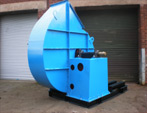 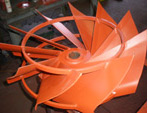 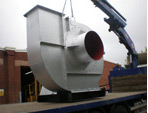 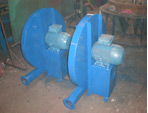 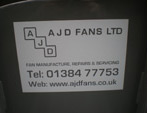
|